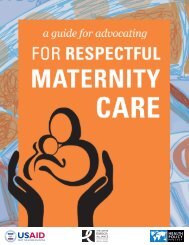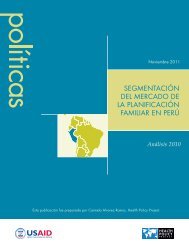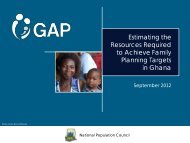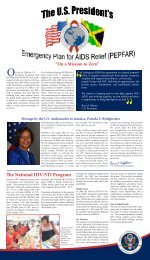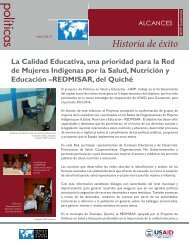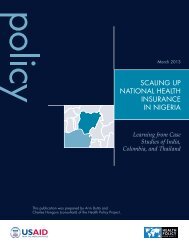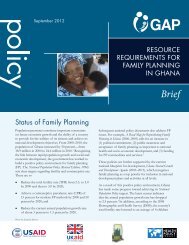Integrating Gender into the Scale-up of Family Planning and ...
Integrating Gender into the Scale-up of Family Planning and ...
Integrating Gender into the Scale-up of Family Planning and ...
- No tags were found...
You also want an ePaper? Increase the reach of your titles
YUMPU automatically turns print PDFs into web optimized ePapers that Google loves.
ContentsAcknowledgments .................................................................................................................. ivIntroduction ...............................................................................................................................1<strong>Scale</strong>-Up <strong>of</strong> Health Interventions .............................................................................................2<strong>Gender</strong> Barriers to <strong>Scale</strong>-Up ..................................................................................................................... 4Meeting <strong>the</strong> Challenges <strong>of</strong> <strong>Scale</strong>-Up: <strong>Gender</strong> Integration ................................................... 5The <strong>Gender</strong> Integration Continuum .......................................................................................................... 5Steps for <strong>Gender</strong> Integration ..................................................................................................................... 6<strong>Gender</strong> Integration in <strong>Scale</strong>-Up Methodologies ....................................................................................... 7<strong>Integrating</strong> <strong>Gender</strong> <strong>into</strong> Priority Interventions for <strong>Scale</strong>-Up .................................................................... 8Examples <strong>of</strong> <strong>Gender</strong>-Integrated <strong>Scale</strong>-Up Efforts .................................................................. 9The Warmi Project—Bolivia .................................................................................................................... 9Community-based Health <strong>Planning</strong> <strong>and</strong> Services <strong>Scale</strong>-Up Model—Ghana ......................................... 10Increasing Health Service Visits <strong>and</strong> <strong>Family</strong> <strong>Planning</strong> Use among Young Women—India .................. 11Lessons Learned from <strong>Integrating</strong> <strong>Gender</strong> <strong>into</strong> <strong>Scale</strong>-Up Efforts ......................................... 13Key Actions to Integrate <strong>Gender</strong> <strong>into</strong> <strong>the</strong> <strong>Scale</strong>-Up Process .............................................. 14References ..............................................................................................................................17iii
IntroductionInternational initiatives, including <strong>the</strong> Millennium Development Goals<strong>and</strong> <strong>the</strong> U.S. Government’s Global Health Initiative, are increasingly <strong>Gender</strong>—<strong>the</strong> roles, responsibibehavior, <strong>and</strong> attributes that arecognizing that gender strongly influences <strong>the</strong> health outcomes <strong>of</strong>particular society considerswomen, men, <strong>and</strong> children. Evidence shows that gender inequality is aappropriate for men <strong>and</strong> wosignificant barrier to achieving improved family planning <strong>and</strong>reproductive health. Multiple studies have shown that gender factors, See http://www.who.int/topics/gsuch as women’s status <strong>and</strong> empowerment (i.e., in education,employment, intimate partner relationships, <strong>and</strong> reproductive health), are linked with women’s capacity toaccess <strong>and</strong> use maternal health services, a critical component <strong>of</strong> maternal health (Gill et al., 2011). Still,family planning is typically viewed as <strong>the</strong> responsibility <strong>of</strong> women, with programs targeting women <strong>and</strong>overlooking <strong>the</strong> role <strong>of</strong> men—even though men’s dominance in decision making, including contraceptiveuse, has significant implications for family planning (Schuler et al., 2011) <strong>and</strong> access to reproductivehealth services (Hou <strong>and</strong> Ma, 2011).Relevant literature indicates that <strong>the</strong> incorporation <strong>of</strong> strategies to address gender inequality can lead toimproved health <strong>and</strong> program outcomes (Barker et al., 2007; Rottach et al., 2009). Many donors <strong>and</strong>program implementers have begun to incorporate strategies <strong>and</strong> approaches that address gender barriers<strong>and</strong> constraints. However, it is not clear that regular attention is being paid to gender factors duringprogram scale-<strong>up</strong>. <strong>Gender</strong> factors influence a range <strong>of</strong> scale-<strong>up</strong> processes, including <strong>the</strong> choice <strong>of</strong> whichpractices to bring to scale, methods <strong>of</strong> scale-<strong>up</strong>, <strong>and</strong> strategies forreaching target populations. Throughout <strong>the</strong> scale-<strong>up</strong> process greaterawareness <strong>of</strong> underlying gender norms <strong>and</strong> factors could streng<strong>the</strong>npact <strong>of</strong> successfully testedscale-<strong>up</strong> efforts through improved underst<strong>and</strong>ing <strong>of</strong> <strong>the</strong> familyore people <strong>and</strong> to foster policy planning <strong>and</strong> maternal, neonatal, <strong>and</strong> child health (FP/MNCH) issuesat h<strong>and</strong>. A more in-depth underst<strong>and</strong>ing <strong>of</strong> <strong>the</strong> situation informslasting basis” (WHO/Exp<strong>and</strong>Net,development <strong>of</strong> strategies for how to increase reach <strong>and</strong> access to <strong>and</strong>use <strong>of</strong> <strong>the</strong> intervention.<strong>Scale</strong>-Up—a process that seeks todeliberately “…increase <strong>the</strong>imhealth innovations so as to benefitm<strong>and</strong> programme development ona2010,p. 2).We conducted a literature review to identify <strong>and</strong> analyze whe<strong>the</strong>r systematic attention to gender factorsduring <strong>the</strong> planning <strong>and</strong> process <strong>of</strong> scaling <strong>up</strong> FP/MNCH programs improves <strong>the</strong> effectiveness <strong>of</strong> thatprocess. Our hypo<strong>the</strong>sis is that incorporating gender strategies during program scale-<strong>up</strong> would in factachieve better programmatic outcomes (e.g., wider availability <strong>of</strong> health services, health interventionsinstitutionalized <strong>and</strong> sustained) <strong>and</strong> health outcomes (e.g., increased contraceptive prevalence rate,decreased maternal mortality rate) among <strong>the</strong>ir clients.lities,men.ender.1
<strong>Scale</strong>-Up <strong>of</strong> Health InterventionsThe term “scale-<strong>up</strong>” is widely used throughout health literature; however, no universal definition exists.This paper uses <strong>the</strong> definition <strong>of</strong> scale-<strong>up</strong> from Exp<strong>and</strong>Net, a global network seeking to advance <strong>the</strong>science <strong>and</strong> practice <strong>of</strong> scaling <strong>up</strong>. The World Health Organization (WHO)/Exp<strong>and</strong>Net (2010) guidedefines scale-<strong>up</strong> as “deliberate efforts to increase <strong>the</strong> impact <strong>of</strong> health innovations tested in pilot orexperimental projects so as to benefit more people <strong>and</strong> to foster policy <strong>and</strong> program development on alasting basis” (p.2).There are four types <strong>of</strong> scale-<strong>up</strong>: horizontal, vertical, functional, <strong>and</strong> spontaneous (WHO/Exp<strong>and</strong>Net,2010):• Horizontal scale-<strong>up</strong>, also known as expansion or replication, is one <strong>of</strong> <strong>the</strong> most commonly usedscale-<strong>up</strong> approaches. It is <strong>the</strong> replication <strong>of</strong> an innovation in o<strong>the</strong>r geographic areas or <strong>the</strong>extension <strong>of</strong> a program to reach a larger or different population.• Vertical scale-<strong>up</strong> is <strong>the</strong> institutionalization <strong>of</strong> an innovation through policy, political, legal,regulatory, budgetary, or o<strong>the</strong>r health systems changes (also see Hardee et al., 2012).• Functional scale-<strong>up</strong>, also known as diversification or grafting, involves testing or adding anew innovation to one that is already being scaled <strong>up</strong>.• Spontaneous scale-<strong>up</strong> is <strong>the</strong> diffusion <strong>of</strong> an innovation without deliberate efforts to spread <strong>the</strong>innovation.We examined <strong>the</strong> first three types (i.e., scale-<strong>up</strong> that is a planned <strong>and</strong> guided process). We did not focusexplicitly on <strong>the</strong> scale-<strong>up</strong> <strong>of</strong> gender-integrated programs, though <strong>the</strong>se programs are included whereappropriate, but ra<strong>the</strong>r on how gender has been integrated in <strong>the</strong> process for scale-<strong>up</strong>.<strong>Scale</strong>-<strong>up</strong> efforts have been guided by many frameworks, approaches, <strong>and</strong> guides. Table 1 provides a list<strong>and</strong> brief descriptions <strong>of</strong> scale-<strong>up</strong> methodologies cited in <strong>the</strong> literature, as well as a discussion on how <strong>the</strong>frameworks address gender.2
Meeting <strong>the</strong> Challenges <strong>of</strong> <strong>Scale</strong>-Up: <strong>Gender</strong>IntegrationThe <strong>Gender</strong> Integration ContinuumTo adequately address <strong>the</strong> gender barriers to scale-<strong>up</strong>, <strong>the</strong> process <strong>of</strong> gender integration can be applied tostreng<strong>the</strong>n scale-<strong>up</strong> efforts. <strong>Gender</strong> integration is <strong>the</strong> process <strong>of</strong> taking <strong>into</strong> account gender norms <strong>and</strong> <strong>the</strong>differences <strong>and</strong> inequalities between men <strong>and</strong> women in program planning, implementation, <strong>and</strong>monitoring <strong>and</strong> evaluation. 1 The USAID-funded Interagency <strong>Gender</strong> Working Gro<strong>up</strong> 2 (IGWG) hasdeveloped a “<strong>Gender</strong> Integration Continuum,” a framework <strong>and</strong> tool for underst<strong>and</strong>ing <strong>the</strong> extent towhich gender has been addressed in programs (see Figure 1). The continuum categorizes approaches byhow <strong>the</strong>y treat gender in <strong>the</strong> design, implementation, <strong>and</strong> evaluation <strong>of</strong> programs <strong>and</strong> policies.Figure 1: <strong>Gender</strong> Integration ContinuumAccording to <strong>the</strong> continuum, programs <strong>and</strong> policies can be ei<strong>the</strong>r gender blind or gender aware. <strong>Gender</strong>blindprograms do not explicitly articulate how gender issues are being addressed; how gender affectsprogram objectives; or how <strong>the</strong> objectives, content, structure, or management <strong>of</strong> programs may affectgender outcomes. In o<strong>the</strong>r words, a gender-blind program ignores—<strong>of</strong>ten unintentionally—underlyinggender constraints <strong>and</strong> opportunities <strong>and</strong> is carried out without specific mention or consideration <strong>of</strong> <strong>the</strong>seunderlying gender considerations. <strong>Gender</strong>-aware programs <strong>and</strong> policies, on <strong>the</strong> o<strong>the</strong>r h<strong>and</strong>,deliberately examine <strong>and</strong> address <strong>the</strong> environment in terms <strong>of</strong> gender <strong>and</strong> consider how gender influencesprogram objectives (Caro, 2009). <strong>Gender</strong>-aware programs may take myriad approaches to incorporatinggender considerations in program design <strong>and</strong> implementation, including conducting gender analysis,1 See http://www.usaid.gov/our_work/cross-cutting_programs/wid/gender/index.html.2 See http://www.igwg.org. This framework draws from a range <strong>of</strong> efforts that have used a continuum <strong>of</strong> approaches tounderst<strong>and</strong>ing gender, especially as <strong>the</strong>y relate to HIV. Also see G<strong>up</strong>ta, 2000; G<strong>up</strong>ta et al., 2002; <strong>and</strong> WHO/ICRW, 2009.5
<strong>Integrating</strong> <strong>Gender</strong> <strong>into</strong> <strong>the</strong> <strong>Scale</strong>-Up <strong>of</strong> <strong>Family</strong> <strong>Planning</strong><strong>and</strong> Maternal, Neonatal, <strong>and</strong> Child Health Programsdeveloping strategies to address gender barriers <strong>and</strong> constraints, monitoring gender-related outcomes, <strong>and</strong>measuring impacts <strong>the</strong> program has on gender equality.The continuum illustrates three strategies for gender integration:1. <strong>Gender</strong>-transformative strategies seek to address gender constraints directly by challenginginequitable gender norms. Examples <strong>of</strong> gender-transformative strategies include promoting <strong>the</strong>status <strong>of</strong> women, addressing power imbalances between women <strong>and</strong> men, or encouraging criticalreflection among women <strong>and</strong> men <strong>of</strong> gender norms <strong>and</strong> roles.2. <strong>Gender</strong>-accommodating strategies also acknowledge gender constraints; however, instead<strong>of</strong> challenging inequitable norms, such strategies seek to accommodate or compensate for <strong>the</strong>m.These types <strong>of</strong> strategies may acknowledge gender constraints <strong>and</strong> design programs to “workaround” <strong>the</strong> constraints so as to improve access to or use <strong>of</strong> health services. <strong>Gender</strong>accommodatingstrategies may include engaging men as decisionmakers in family planning orconducting advocacy with community leaders to s<strong>up</strong>port family planning.3. <strong>Gender</strong>-exploitative strategies, found on <strong>the</strong> left side <strong>of</strong> <strong>the</strong> continuum, take advantage <strong>of</strong>rigid gender norms <strong>and</strong> existing imbalances in power to achieve <strong>the</strong> health program objectives.These types <strong>of</strong> approaches can exasperate existing gender inequality <strong>and</strong> undermine programefforts in <strong>the</strong> long term. One example <strong>of</strong> a gender-exploitative approach is to reinforce men’sdominance in decision making in order to increase contraceptive use. <strong>Gender</strong>-exploitativeapproaches are not appropriate strategies for gender integration. As Caro (2009) noted, “Theoverall objective <strong>of</strong> gender integration is to move toward gender transformativeprograms/policies, thus gradually challenging existing gender inequities <strong>and</strong> promoting positivechanges in gender roles, norms, <strong>and</strong> power dynamics.”<strong>Gender</strong> approaches may not fall neatly under one integration category. For example, one strategy may beaccommodative in one context <strong>and</strong> transformative in ano<strong>the</strong>r, or an accommodative strategy mayunexpectedly lead to transformative outcomes such as positive changes in gender norms. The continuumis a useful tool for underst<strong>and</strong>ing <strong>the</strong> range <strong>of</strong> gender-integration approaches <strong>and</strong> how <strong>the</strong>y addressinequitable gender norms.Steps for <strong>Gender</strong> Integration<strong>Gender</strong> integration is an iterative process that occurs throughout a program. While a framework specificto integrating gender <strong>into</strong> scale-<strong>up</strong> processes does not exist, important lessons can be drawn from <strong>the</strong>process for integrating gender <strong>into</strong> programs <strong>and</strong> policies. The five steps <strong>of</strong> gender integration include <strong>the</strong>following: 31. <strong>Gender</strong> analysis. Collect data on gender relations, norms, roles, <strong>and</strong> responsibilities in relationto <strong>the</strong> health needs to be addressed by <strong>the</strong> program <strong>and</strong> analyze that information to identifygender-based constraints <strong>and</strong> opportunities. <strong>Gender</strong> analyses should be conducted throughout <strong>the</strong>program.2. Strategic planning. Using <strong>the</strong> results <strong>of</strong> <strong>the</strong> gender analysis, examine <strong>and</strong> revise programobjectives to streng<strong>the</strong>n linkages between gender <strong>and</strong> health goals. It is important to define3 The process <strong>of</strong> gender integration described here is adapted from Caro 2009.
Meeting <strong>the</strong> Challenges <strong>of</strong> <strong>Scale</strong>-Up: <strong>Gender</strong> Integrationgender objectives so as to explicitly articulate what <strong>the</strong> program is trying to achieve in terms <strong>of</strong>gender outcomes, such as increasing gender equitable attitudes. <strong>Gender</strong> objectives will be usefulin identifying appropriate approaches to meet those objectives.3. Designing <strong>and</strong> adapting. Design interventions <strong>and</strong> approaches in s<strong>up</strong>port <strong>of</strong> gender <strong>and</strong> healthobjectives. Consideration should be given to whe<strong>the</strong>r gender accommodating or gendertransformative approaches, or a combination <strong>of</strong> <strong>the</strong> two, would be most effective in achievingboth improved gender <strong>and</strong> health outcomes. Findings from <strong>the</strong> gender analysis should be used toinform <strong>the</strong> development <strong>of</strong> gender approaches.4. Monitoring. Develop indicators to measure progress toward gender <strong>and</strong> health outcomes, as wellas <strong>the</strong> implementation process. Special emphasis should be placed on monitoring how <strong>the</strong>program is meeting <strong>the</strong> needs <strong>of</strong> women <strong>and</strong> men. Throughout implementation, it is important tore-examine <strong>the</strong> gender analysis to determine whe<strong>the</strong>r additional constraints or opportunities areemerging <strong>and</strong> <strong>the</strong>n adjust <strong>the</strong> program accordingly.5. Evaluation. Evaluate <strong>the</strong> effectiveness <strong>of</strong> <strong>the</strong> program in achieving gender <strong>and</strong> health outcomes.Evaluations can help to determine whe<strong>the</strong>r program activities are affecting gender <strong>and</strong> healthoutcomes as intended <strong>and</strong> to inform redesign, where necessary.<strong>Gender</strong> Integration in <strong>Scale</strong>-Up MethodologiesThere are numerous approaches <strong>and</strong> frameworks to guide <strong>the</strong> scale-<strong>up</strong> <strong>of</strong> health programs, but gender haslargely been ignored in <strong>the</strong> majority <strong>of</strong> scale-<strong>up</strong> frameworks. Two exceptions are <strong>the</strong> United NationsPopulation Fund-International Confederation <strong>of</strong> Midwives (UNFPA-ICM) Joint Initiative programguidance <strong>and</strong> <strong>the</strong> Exp<strong>and</strong>Net framework, both <strong>of</strong> which incorporate a gender perspective.<strong>Scale</strong>-<strong>up</strong> Methodologies that Include a <strong>Gender</strong> PerspectiveUNFPA-ICM: Asserts <strong>the</strong> importance <strong>of</strong> gender equality, gender sensitivity in service provision, <strong>and</strong>gender-sensitive policies <strong>and</strong> practices in <strong>the</strong> process <strong>of</strong> scaling <strong>up</strong> human resources for midwiferyservices. Although <strong>the</strong> document does not provide specific guidance on operationalizing gendersensitivescale-<strong>up</strong> processes, fur<strong>the</strong>r technical guidance on scaling <strong>up</strong> midwifery programs are beingdeveloped.Exp<strong>and</strong>Net: Mentions gender perspectives as an underlying principle <strong>of</strong> <strong>the</strong> framework: “respect forhuman rights, equity <strong>and</strong> gender perspectives,” with <strong>the</strong> recommendation that “…scaling <strong>up</strong> shouldensure attention to human dignity, <strong>the</strong> needs <strong>and</strong> rights <strong>of</strong> vulnerable gro<strong>up</strong>s <strong>and</strong> gender perspectivesas well as promote equitable access for all to quality services.” This principle is mentioned in <strong>the</strong>Exp<strong>and</strong>Net nine-step guide for developing a scale-<strong>up</strong> strategy, but <strong>the</strong> guidance fails to provide adefinition <strong>of</strong> gender perspectives <strong>and</strong> lacks clear guidance or resources about how to operationalizegender perspectives throughout <strong>the</strong> scale-<strong>up</strong> process.O<strong>the</strong>r scale-<strong>up</strong> frameworks (see Table 1 on page 3) make no mention <strong>of</strong> gender or gender integration, acritical gap in <strong>the</strong> scale-<strong>up</strong> literature. Given that <strong>the</strong>re are numerous gender-related barriers to scale-<strong>up</strong>,without a scale-<strong>up</strong> framework or guidance on how to address <strong>the</strong>se barriers, <strong>the</strong> success <strong>and</strong> effectiveness<strong>of</strong> scale-<strong>up</strong> initiatives may be limited.7
<strong>Integrating</strong> <strong>Gender</strong> <strong>into</strong> <strong>the</strong> <strong>Scale</strong>-Up <strong>of</strong> <strong>Family</strong> <strong>Planning</strong><strong>and</strong> Maternal, Neonatal, <strong>and</strong> Child Health Programs<strong>Integrating</strong> <strong>Gender</strong> <strong>into</strong> Priority Interventions for <strong>Scale</strong>-UpOne commonality across all <strong>the</strong> scale-<strong>up</strong> frameworks is that any approach or intervention to be scaled <strong>up</strong>must first be piloted <strong>and</strong> shown to have some level <strong>of</strong> effectiveness or success. Pilot projects <strong>and</strong>interventions are a foundational component <strong>of</strong> scale-<strong>up</strong>, <strong>and</strong> <strong>the</strong>refore, it is important to look critically at<strong>the</strong> priority interventions identified for scale-<strong>up</strong> <strong>and</strong> underst<strong>and</strong> <strong>the</strong> degree to which <strong>the</strong>y integrate gender.Many donors <strong>and</strong> nongovernmental <strong>and</strong> o<strong>the</strong>r organizations have undertaken efforts to identify <strong>and</strong>prioritize approaches <strong>and</strong> interventions that are effective in improving health outcomes <strong>and</strong> could bebrought to scale. These are <strong>of</strong>ten referred to as evidence-based, best, proven, or good practices. Thesepractices include a range <strong>of</strong> interventions, services, <strong>and</strong> programs that have some level <strong>of</strong> evidence <strong>of</strong>effectiveness or success. These practices can fall in several categories: clinical practices or services (e.g.,use <strong>of</strong> misoprostol to prevent post-partum hemorrhage), packages <strong>of</strong> interventions (e.g., essential newborncare), methods <strong>of</strong> delivery (e.g., social marketing channels or community health workers), <strong>and</strong>management or programmatic activities (e.g., s<strong>up</strong>portive s<strong>up</strong>ervision).It is difficult to assess <strong>the</strong> level <strong>of</strong> gender integration in lists <strong>of</strong> best practices because <strong>of</strong> a lack <strong>of</strong>available information on <strong>the</strong> selection criteria used for identifying <strong>the</strong> practices. On <strong>the</strong> surface, however,it appears that clinical practices <strong>and</strong> services are largely gender blind 4 (i.e., according to <strong>the</strong> <strong>Gender</strong>Integration Continuum, <strong>the</strong>y do not explicitly articulate how gender issues are being addressed, howgender affects program objectives, or how programs may affect gender outcomes). This would not besurprising, as <strong>the</strong> focus <strong>of</strong> clinical practices is on medical procedures <strong>and</strong> outcomes ra<strong>the</strong>r than onequitable access, treatment, or delivery. More information about <strong>the</strong> selection criteria is needed, however,before this determination can be made.Never<strong>the</strong>less, clinical practices <strong>and</strong> services that do not explicitly integrate gender (<strong>and</strong> <strong>the</strong>refore are notconsidered gender-integrated) can be delivered or implemented using gender-integrated approaches.For example, <strong>the</strong> Extending Service Delivery Project used various gender-integrated approaches todeliver healthy timing <strong>and</strong> spacing <strong>of</strong> pregnancy (HTSP) messages <strong>and</strong> education in India <strong>and</strong> Egypt. Theproject engaged husb<strong>and</strong>s <strong>and</strong> mo<strong>the</strong>rs-in-law in seminars to discuss <strong>the</strong> benefits <strong>of</strong> HTSP <strong>and</strong> workedwith communities (husb<strong>and</strong>s, mo<strong>the</strong>rs-in-laws, religious leaders, <strong>and</strong> local authorities) to change socialnorms around contraceptives (Bitar, 2011).O<strong>the</strong>r examples <strong>of</strong> gender-aware best practices in literature can be used to s<strong>up</strong>port delivery <strong>of</strong> <strong>and</strong> accessto clinical practices <strong>and</strong> services. These practices include working with social networks to change socialnorms in s<strong>up</strong>port <strong>of</strong> family planning; consulting women on how services can meet <strong>the</strong>ir needs; involvingwomen in changes <strong>and</strong> monitoring quality (USAID, 2011); engaging men in FP counseling; <strong>and</strong>conducting advocacy in gender-based violence or girls education. 5 There is increasing evidence <strong>of</strong> <strong>the</strong>impact <strong>of</strong> gender integration on health outcomes <strong>and</strong> on basic program implementation; however, morerigorous monitoring <strong>and</strong> evaluation <strong>of</strong> <strong>the</strong>se gender-aware delivery methods is needed to underst<strong>and</strong> how<strong>the</strong>y influence <strong>and</strong> affect scale-<strong>up</strong>, both in terms <strong>of</strong> spread <strong>and</strong> institutionalization (horizontal <strong>and</strong> verticalscale-<strong>up</strong>).4 A prerequisite <strong>of</strong> any gender-integrated project or intervention is that it be gender-aware. Therefore, any gender-blindintervention would not be a gender-integrated intervention.5 This list <strong>of</strong> best practices was developed by <strong>the</strong> Extending Service Delivery Project <strong>and</strong> disseminated during its end-<strong>of</strong>-projectworkshop in June 2011 in Washington, DC.
Examples <strong>of</strong> <strong>Gender</strong>-Integrated <strong>Scale</strong>-Up EffortsProgram managers <strong>and</strong> planners interested in integrating gender in scale-<strong>up</strong> face myriad challenges, aseach setting is unique, program objectives may differ, <strong>and</strong> applying <strong>the</strong> elements from a framework on anoperational level can be difficult for institutions lacking prior experience. What <strong>the</strong> literature shows,however, is that incorporating at least some elements from evidence-based frameworks <strong>and</strong> best practicesmakes a difference in how programs function <strong>and</strong> whe<strong>the</strong>r gender considerations are addressed.At <strong>the</strong> same time, <strong>the</strong>re is no specific roadmap that a given program can follow to ensure genderintegration in scale-<strong>up</strong>. The following three case studies—which illustrate both successes <strong>and</strong>challenges—are <strong>the</strong>refore instructive in how different programs addressed integration. Each started with acommitment to do so <strong>and</strong> found ways to be both strategic <strong>and</strong> flexible in creating approaches to meet <strong>the</strong>irobjectives. Importantly, all three case studies applied a systematic approach to scale-<strong>up</strong> <strong>and</strong> providelessons learned for integrating gender <strong>into</strong> scale-<strong>up</strong> efforts.The Warmi Project—BoliviaThe Warmi Project, implemented in Bolivia by Save <strong>the</strong> Children, Inc., started in 1990 as a demonstrationproject in Inquisivi Province (Gonzalez et al., 1998). The project used a participatory methodology, nowtermed <strong>the</strong> Community Action Cycle, to improve maternal <strong>and</strong> neonatal health at <strong>the</strong> community level.The Community Action Cycle consists <strong>of</strong> four phases: autodiagnosis, or problem identification <strong>and</strong>prioritization; planning toge<strong>the</strong>r; implementation; <strong>and</strong> participatory evaluation.Following a successful demonstration project, <strong>the</strong> project began an expansion phase <strong>of</strong> <strong>the</strong> CommunityAction Cycle in eight <strong>of</strong> Bolivia’s nine departments, reaching more than 500 communities <strong>and</strong> 200,000women <strong>of</strong> reproductive age. Save <strong>the</strong> Children held participatory workshops <strong>and</strong> follow-<strong>up</strong> coaching <strong>and</strong>mentoring visits in each region throughout <strong>the</strong> country to train nongovernmental organizations <strong>and</strong> districtministry <strong>of</strong> health facilitators in <strong>the</strong> Community Action Cycle methodology. Project partners were given<strong>the</strong> flexibility <strong>and</strong> s<strong>up</strong>port to adapt <strong>the</strong> methodology to <strong>the</strong>ir local context, but in general, project partnersused <strong>the</strong> following scale-<strong>up</strong> strategies:• Develop, implement, <strong>and</strong> document a successful demonstration project• Disseminate project methods <strong>and</strong> results• Advocate to build consensus <strong>and</strong> influence policy• Mobilize resources• Define <strong>the</strong> organizational structure <strong>and</strong> philosophy <strong>of</strong> <strong>the</strong> national project• Establish agreements with partners (Ministry <strong>of</strong> Health <strong>and</strong> nongovernmental organizations)• Provide training <strong>and</strong> technical assistance• Coordinate activities with partner agencies• Develop <strong>and</strong> use monitoring <strong>and</strong> evaluation systems• Sustain health improvements <strong>and</strong> use <strong>of</strong> <strong>the</strong> project methodology in <strong>the</strong> futureThe Warmi Project developed <strong>and</strong> implemented a systematic scale-<strong>up</strong> strategy that overlapped in manyways with <strong>the</strong> scale-<strong>up</strong> framework developed by Exp<strong>and</strong>Net (2010). For example, scale-<strong>up</strong> began with ademonstration project to test <strong>the</strong> effectiveness <strong>of</strong> <strong>the</strong> Community Action Cycle. The scale-<strong>up</strong> strategyincluded both horizontal scale-<strong>up</strong> (exp<strong>and</strong>ing geographic coverage to more than 500 communities) <strong>and</strong>9
Examples <strong>of</strong> <strong>Gender</strong>-Integrated <strong>Scale</strong>-Up EffortsImportantly, <strong>the</strong> CHPS initiative incorporated a number <strong>of</strong>Ghana: <strong>Gender</strong>-Integrated StrategiesDuring <strong>Scale</strong>-Upgender-integrated practices <strong>and</strong> approaches throughout <strong>the</strong>scale-<strong>up</strong> process. First, during <strong>the</strong> testing <strong>of</strong> <strong>the</strong>• During community entry, engaged a innovation, <strong>the</strong> project was attentive to <strong>the</strong> needs <strong>of</strong> bothbroad range <strong>of</strong> stakeholders, men <strong>and</strong> women <strong>and</strong> elicited <strong>the</strong>ir input on how to addressincluding village leaders, men,gender constraints in <strong>the</strong> service model. During <strong>the</strong> scalewomen,<strong>and</strong> health workers, to assess<strong>up</strong> phase, exp<strong>and</strong>ing <strong>the</strong> service model to new<strong>the</strong>ir perceived needs <strong>of</strong> healthcommunities included two important gender-integratedstrategies.services <strong>and</strong> inform adaptations to<strong>the</strong> program.• Provided community volunteers witha six-week training course incommunity health mobilization,which emphasized promoting familyplanning <strong>and</strong> reproductive healthamong men <strong>and</strong> engaging <strong>the</strong>irs<strong>up</strong>port <strong>and</strong> participation.A study conducted by Adongo <strong>and</strong> o<strong>the</strong>rs (forthcoming)showed that during pilot testing (an experiment known as<strong>the</strong> Navrongo Community Health <strong>and</strong> <strong>Family</strong> <strong>Planning</strong>Project), male mobilization strategies combined withfamily planning service provision were effective insignificantly reducing <strong>the</strong> total fertility rate in <strong>the</strong>experimental villages. According to <strong>the</strong> same authors,volunteers who joined <strong>the</strong> program following completion <strong>of</strong> <strong>the</strong> study did not receive training in malemobilization methods, an unfortunate omission. Interestingly, <strong>the</strong>y found that during <strong>the</strong> expansion phase,areas not implementing or that had not initially implemented <strong>the</strong> male mobilization approach did not seesignificant decline in fertility rates. It appears that scale-<strong>up</strong> <strong>of</strong> <strong>the</strong> CHPS could have benefitted frominstitutionalization (vertical scale-<strong>up</strong>) <strong>of</strong> <strong>the</strong> male mobilization approach, which proved successful incombination with health service provision.The experience in Ghana with this national, government-led initiative to scale-<strong>up</strong> health services using agender-integrated scale-<strong>up</strong> strategy, demonstrates that gender strategies can have a positive impact onhealth <strong>and</strong> gender outcomes; however, institutionalization <strong>of</strong> such approaches is necessary to sustain <strong>the</strong>ircontinued expansion to o<strong>the</strong>r areas.Increasing Health Service Visits <strong>and</strong> <strong>Family</strong> <strong>Planning</strong> Use among YoungWomen—IndiaThe final case study illustrates <strong>the</strong> importance <strong>of</strong> addressinggender barriers throughout <strong>the</strong> scale-<strong>up</strong> process. Incollaboration with <strong>the</strong> Extending Service Delivery Project,During <strong>Scale</strong>-Up<strong>the</strong> Population Council led a project to scale <strong>up</strong> highqualityantenatal <strong>and</strong> postpartum care in Uttar Pradesh,included <strong>the</strong>m as a targetIndia (Bitar, 2011). The program sought to exp<strong>and</strong> such11India: <strong>Gender</strong>-Integrated Strategies• Engaged men in FP counseling <strong>and</strong>audience for FP messages <strong>and</strong>education.care through a package <strong>of</strong> interventions that includedintegrating family planning counseling <strong>into</strong> antenatal care<strong>and</strong> postpartum services; exp<strong>and</strong>ing family planning <strong>and</strong> maternal, neonatal, <strong>and</strong> child health education tohusb<strong>and</strong>s, mo<strong>the</strong>rs-in-law, <strong>and</strong> community leaders; introducing community worker s<strong>up</strong>ervision; <strong>and</strong>fostering coordination <strong>and</strong> partnerships.Following an operations research phase, <strong>the</strong> project was replicated in 52 villages. To implement <strong>the</strong>package <strong>of</strong> interventions, several activities were carried out: training <strong>of</strong> community health workers <strong>and</strong>
<strong>Integrating</strong> <strong>Gender</strong> <strong>into</strong> <strong>the</strong> <strong>Scale</strong>-Up <strong>of</strong> <strong>Family</strong> <strong>Planning</strong><strong>and</strong> Maternal, Neonatal, <strong>and</strong> Child Health Programsprivate practitioners; implementation <strong>of</strong> education campaigns targeting women, husb<strong>and</strong>s, mo<strong>the</strong>rs-inlaw,<strong>and</strong> opinion leaders; <strong>and</strong> <strong>the</strong> establishment <strong>of</strong> a s<strong>up</strong>ervision system. Findings from an analysis <strong>of</strong> <strong>the</strong>replication showed a number <strong>of</strong> positive program <strong>and</strong> health outcomes. Results included increases in <strong>the</strong>proportion <strong>of</strong> community health workers who counseled on family planning <strong>and</strong> safe mo<strong>the</strong>rhood issues,greater use <strong>of</strong> family planning methods by co<strong>up</strong>les in <strong>the</strong> communities studied, <strong>and</strong> increases in antenatalcare visits.The project also identified numerous challenges, ranging from logistical <strong>and</strong> operational to socio-culturalconstraints. One key challenge was <strong>the</strong> existing patriarchal society in rural India. The fact that men are <strong>the</strong>household decisionmakers posed challenges for increasing contraceptive use among program participants,since women in <strong>the</strong> program did not always have <strong>the</strong> autonomy to decide whe<strong>the</strong>r to use contraceptives orwhich method to choose. Within <strong>the</strong> intervention, additional strategies could have included empoweringwomen to negotiate contraceptive use <strong>and</strong> efforts to increase shared decision making. Within <strong>the</strong> scale-<strong>up</strong>process, additional strategies could have been used to advocate for or s<strong>up</strong>port women’s contraceptive use<strong>and</strong> reproductive rights.
Lessons Learned from <strong>Integrating</strong> <strong>Gender</strong> <strong>into</strong><strong>Scale</strong>-Up EffortsDuring our analysis <strong>of</strong> case studies <strong>and</strong> o<strong>the</strong>r gray <strong>and</strong> published literature, we identified many lessonslearned in scaling <strong>up</strong> health interventions that address gender (see <strong>the</strong> Recommendations section).Importantly, we noted that scant evidence exists on <strong>the</strong> impact <strong>of</strong> gender integration on <strong>the</strong> effectiveness<strong>of</strong> scale-<strong>up</strong> efforts, both in terms <strong>of</strong> programmatic outcomes (e.g., wider availability <strong>of</strong> health services,health interventions institutionalized <strong>and</strong> sustained) <strong>and</strong> health outcomes (e.g., increased contraceptiveprevalence rate, decreased maternal mortality rate). Moreover, we found few scale-<strong>up</strong> frameworks <strong>and</strong>methodologies that systematically integrate gender <strong>into</strong> <strong>the</strong> process <strong>of</strong> program scale-<strong>up</strong>. Likewise, fewprograms have systematically integrated gender throughout <strong>the</strong> scale-<strong>up</strong> process. Even those that didintegrate gender <strong>into</strong> <strong>the</strong> scale-<strong>up</strong> process did not adequately monitor <strong>and</strong> evaluate <strong>the</strong> effects <strong>of</strong>addressing gender in program planning or design, making it difficult to ascertain <strong>the</strong> true impact <strong>of</strong> genderintegration on scale-<strong>up</strong>. The following are some <strong>of</strong> <strong>the</strong> key lessons identified:• Increasing access to a health service, promoting social or behavior change, orimproving <strong>the</strong> use <strong>of</strong> health products all require increases in dem<strong>and</strong> (ImplementingBest Practices Consortium, 2007). <strong>Gender</strong> norms can act as barriers to dem<strong>and</strong> creation by notappropriately meeting <strong>the</strong> needs <strong>of</strong> women or not addressing <strong>the</strong> concerns <strong>of</strong> men. Underst<strong>and</strong>ing<strong>the</strong> socio-cultural environment, including gender roles <strong>and</strong> norms, is critical to achievingimproved health outcomes (Bitar, 2011; Gonzalez et al., 2008; Nyonator et al., 2007; Nyonator etal., 2005).• Engaging a broad range <strong>of</strong> stakeholders representing men’s <strong>and</strong> women’s gro<strong>up</strong>s isimportant for program effectiveness (Gonzalez et al., 2008; Nyonator et al., 2007; Nyonator et al.,2005). Increasing ownership <strong>and</strong> acceptance <strong>of</strong> an intervention or practice is increaseddramatically when communities are engaged <strong>and</strong> drive <strong>the</strong> process. Ensuring broad representationcan increase <strong>the</strong> likelihood that <strong>the</strong> intervention meets <strong>the</strong> needs <strong>of</strong> women, men, <strong>and</strong> vulnerablepopulations.• When scaling <strong>up</strong> a given intervention to o<strong>the</strong>r geographic areas—such as exp<strong>and</strong>ing familyplanning to remote areas—<strong>the</strong> intervention <strong>and</strong> scale-<strong>up</strong> strategy may need adjusting t<strong>of</strong>it different contexts in terms <strong>of</strong> gender (Bitar, 2011; Gonzalez et al., 2008). Adaptation <strong>of</strong>an intervention to new contexts, without comprising <strong>the</strong> fidelity <strong>of</strong> <strong>the</strong> intervention, is critical toits acceptance <strong>and</strong> success. Additionally, acceptance <strong>of</strong> <strong>and</strong> buy-in to <strong>the</strong> intervention beingscaled <strong>up</strong> can be improved through <strong>the</strong> application <strong>of</strong> gender-integrated strategies to deliver a bestpractice (Gonzalez et al., 2008; Nyonator et al., 2007; Nyonator et al., 2005).• Government commitment, in terms <strong>of</strong> policy <strong>and</strong> additional resources, is necessaryin effectively scaling <strong>up</strong> gender approaches <strong>and</strong> integrating gender <strong>into</strong> <strong>the</strong> scale<strong>up</strong>process (Nyonator et al., 2007; Nyonator et al., 2005).• Improved monitoring <strong>and</strong> evaluation systems are needed to underst<strong>and</strong> how integratinggender <strong>into</strong> scale-<strong>up</strong> frameworks <strong>and</strong> processes can affect <strong>the</strong> effectiveness <strong>of</strong> scaling <strong>up</strong> healthinterventions.13
Key Actions to Integrate <strong>Gender</strong> <strong>into</strong> <strong>the</strong> <strong>Scale</strong>-UpProcessA critical appraisal <strong>of</strong> scale-<strong>up</strong> methods <strong>and</strong> selected experiences by different programs <strong>and</strong> in variouscountries with scale-<strong>up</strong> suggests that insufficient attention is paid to gender. Given <strong>the</strong> known impact thataddressing gender factors can have on <strong>the</strong> successful implementation or adoption <strong>of</strong> proven healthpractices, it is reasonable to hypo<strong>the</strong>size that a more systematic approach to ensuring gender awareness inscale-<strong>up</strong> processes could significantly improve <strong>the</strong> effectiveness <strong>of</strong> such efforts. Donors <strong>and</strong> implementersshould undertake efforts to integrate gender <strong>into</strong> scale-<strong>up</strong> projects, measure <strong>the</strong> impact <strong>of</strong> doing so, <strong>and</strong>share <strong>the</strong> outcomes <strong>of</strong> <strong>the</strong>se efforts.To systematically integrate gender <strong>into</strong> <strong>the</strong> scale-<strong>up</strong> process, program planners <strong>and</strong> managers shouldconsider <strong>the</strong> following steps <strong>and</strong> recommendations. Given <strong>the</strong> limited evidence on <strong>the</strong> impact <strong>of</strong>operationalizing <strong>the</strong>se recommendations, all could warrant fur<strong>the</strong>r investigation: 6Preliminary Phase: Integration <strong>into</strong> scale-<strong>up</strong> frameworks <strong>and</strong> approaches• Integrate gender <strong>into</strong> scale-<strong>up</strong> frameworks <strong>and</strong> approaches. There are manyopportunities <strong>and</strong> entry points for integrating gender <strong>into</strong> scale-<strong>up</strong> frameworks. As an importantfirst step, authors <strong>and</strong> developers <strong>of</strong> scale-<strong>up</strong> frameworks should more clearly articulate <strong>the</strong> role<strong>of</strong> gender in scale-<strong>up</strong> processes. This adaptation should also include development <strong>of</strong> guidingprinciples for a gender-integrated scale-<strong>up</strong> process. Lastly, existing gender integrationframeworks can be adapted to provide concrete guidance on operationalizing gender integrationin scale-<strong>up</strong>.Step 1: Pilot testing• Conduct a gender assessment. Identify <strong>and</strong> address gender barriers <strong>and</strong> opportunitiesrelevant to scale-<strong>up</strong>, as a part <strong>of</strong> <strong>the</strong> process for assessing scalability <strong>of</strong> a best practice. It can beviewed as a process for screening a best practice to underst<strong>and</strong> how it would influence genderoutcomes <strong>and</strong> what, in terms <strong>of</strong> gender, should be monitored. <strong>Gender</strong> assessments should helpinform decisions about how to scale <strong>up</strong> <strong>and</strong> guide development <strong>of</strong> a scale-<strong>up</strong> roadmap.Assessments should be conducted throughout <strong>the</strong> scale-<strong>up</strong> process to ensure adequate monitoring<strong>and</strong> evaluation <strong>of</strong> <strong>the</strong> program in terms <strong>of</strong> gender outcomes.• Develop approaches to address gender that can be brought to scale. A number <strong>of</strong>gender-integrated pilot or small-scale <strong>and</strong> time-intensive projects have been tested <strong>and</strong> shown toimprove health <strong>and</strong> gender outcomes. Emphasis should be placed on testing gender-integratedinnovations to determine costs <strong>and</strong> feasibility <strong>of</strong> scaling <strong>up</strong> <strong>the</strong> interventions.Step 2: <strong>Planning</strong> <strong>and</strong> team formation• Form a gender diverse resource team.o Engage a broad range <strong>of</strong> stakeholders representing women’s <strong>and</strong> men’s gro<strong>up</strong>s <strong>and</strong>vulnerable populations. Meaningful participation from myriad stakeholders ensures that6 Many recommendations were discussed during <strong>the</strong> Expert Meeting on Policy Implementation <strong>and</strong> <strong>Gender</strong> Integration in <strong>Scale</strong>-Up <strong>of</strong> FP/MNCH Best Practices, held December 12, 2011, at Futures Gro<strong>up</strong> in Washington, DC.14
Key Actions to Integrate <strong>Gender</strong> <strong>into</strong> <strong>the</strong> <strong>Scale</strong>-Up Processmultiple perspectives <strong>and</strong> opinions inform <strong>the</strong> design <strong>and</strong> implementation <strong>of</strong> health programs.Broad engagement also increases cultural sensitivity, awareness <strong>of</strong> underlying gender barriers<strong>and</strong> constraints, <strong>and</strong> community ownership. Consider as well that women <strong>and</strong> men are nothomogenous gro<strong>up</strong>s <strong>and</strong> <strong>the</strong>refore should be fur<strong>the</strong>r disaggregated by age, ethnicity, <strong>and</strong>o<strong>the</strong>r relevant characteristics.• Provide gender training, s<strong>up</strong>port, <strong>and</strong> team building.o As part <strong>of</strong> <strong>the</strong> team-building process, provide training on rights <strong>and</strong> gender integration orgender mainstreaming. The data from <strong>the</strong> gender assessment can be used to inform <strong>the</strong>training’s content <strong>and</strong> tailor it to <strong>the</strong> gender context.o S<strong>up</strong>port development <strong>of</strong> a shared vision among <strong>the</strong> resource team <strong>of</strong> <strong>the</strong> practice to be scaled<strong>up</strong> <strong>and</strong> <strong>the</strong> gender dimensions <strong>and</strong> considerations connected with <strong>the</strong> practice.• Develop gender objectives.o Using <strong>the</strong> results <strong>of</strong> <strong>the</strong> gender assessment, develop scale-<strong>up</strong> <strong>and</strong> program objectives forgender equality.Step 3: Development <strong>of</strong> a scale-<strong>up</strong> strategy• Map strategies to address gender-based constraints <strong>and</strong> opportunities.o Conduct a mapping exercise to identify how <strong>and</strong> when to address gender-based constraints<strong>and</strong> opportunities <strong>and</strong> reduce gender equality gaps throughout <strong>the</strong> scale-<strong>up</strong> process. Amapping tool or similar exercise will help ensure that <strong>the</strong> findings from <strong>the</strong> gender analysisare brought <strong>into</strong> <strong>the</strong> planning <strong>and</strong> strategy development process <strong>and</strong> can inform <strong>the</strong>development <strong>of</strong> a gender-aware scale-<strong>up</strong> strategy. See <strong>the</strong> Maternal <strong>and</strong> Child HealthImprovement Program’s scale-<strong>up</strong> framework for a sample mapping tool that could be adaptedto integrate gender (Fujikoya <strong>and</strong> Smith, 2011).• Mobilize resources.o Mobilize resources for gender-integrated programs through advocacy to decisionmakers <strong>and</strong>policymakers. Adequate political commitment <strong>and</strong> financial resources for scaling <strong>up</strong> healthprograms using approaches that address gender considerations in a systematic way are crucialto success, both in terms <strong>of</strong> programmatic outcomes <strong>and</strong> health outcomes. Emphasis shouldbe placed on increasing commitments for integrating gender throughout <strong>the</strong> scale-<strong>up</strong> process.Step 4: Monitoring <strong>and</strong> evaluation• Measure gender-based constraints <strong>and</strong> opportunities.o Use <strong>the</strong> results <strong>of</strong> <strong>the</strong> gender assessment to inform development <strong>of</strong> <strong>the</strong> monitoring <strong>and</strong>evaluation plan to better underst<strong>and</strong> how gender factors influence <strong>the</strong> process, outcomes, <strong>and</strong>impact. The monitoring <strong>and</strong> evaluation plan should include gender-specific indicators <strong>and</strong>benchmarks, as well as <strong>the</strong> collection <strong>of</strong> sex-disaggregated data. The process <strong>of</strong> scale-<strong>up</strong>, aswell as health <strong>and</strong> gender equality, should be measured.oOverall, little evidence exists on <strong>the</strong> role <strong>of</strong> gender in <strong>the</strong> scale-<strong>up</strong> process. Program planners<strong>and</strong> implementers have an important role in building <strong>the</strong> evidence base for gender integration<strong>and</strong> scale-<strong>up</strong> so health decisionmakers worldwide can better underst<strong>and</strong> how to design,implement, <strong>and</strong> monitor scale-<strong>up</strong> efforts that will lead to equitable <strong>and</strong> more sustainablehealth outcomes.15
<strong>Integrating</strong> <strong>Gender</strong> <strong>into</strong> <strong>the</strong> <strong>Scale</strong>-Up <strong>of</strong> <strong>Family</strong> <strong>Planning</strong><strong>and</strong> Maternal, Neonatal, <strong>and</strong> Child Health ProgramsStep 5: Implementation• Make <strong>the</strong> scale-<strong>up</strong> process participatory <strong>and</strong> inclusive.o Establish feedback mechanisms to enable proper monitoring <strong>and</strong> ensure that necessaryadjustments can be identified.• Monitor discrimination <strong>and</strong> <strong>the</strong> exercise <strong>of</strong> rights.o During implementation, scale-<strong>up</strong> programs should monitor discrimination against orperceived by women, men, <strong>and</strong> vulnerable gro<strong>up</strong>s to ensure equitable access to services <strong>and</strong>products <strong>and</strong> fair <strong>and</strong> respectful treatment by health providers.
ReferencesAdongo, P.B., J.F. Phillips, <strong>and</strong> C.D. Baynes. Forthcoming. “Addressing Men's Concernsabout Reproductive Health Services <strong>and</strong> Fertility Regulation in a Rural Sahelian Setting <strong>of</strong> Nor<strong>the</strong>rnGhana: The ‘Zurugelu Approach.’” Forthcoming in Kulczycki, Andrzej (ed.) Critical Issues inReproductive Health. New York: Springer Books.Barker, G., C. Ricardo, <strong>and</strong> M. Nascimento. 2007. Engaging Men <strong>and</strong> Boys in Changing <strong>Gender</strong>-BasedInequity in Health: Evidence from Programme Interventions. Geneva: World Health Organization(WHO).Battistella Nemes, M.I., J. Beaudoin, S. Conway, G.W. Kivumbi, A. Skjelmerud, <strong>and</strong> U. Vogel. 2006.Evaluation <strong>of</strong> WHO’s Contribution to “3 by 5.” Geneva: WHO.Bitar, S. 2011. “Increasing Health Service Visits <strong>and</strong> <strong>Family</strong> <strong>Planning</strong> Use among Young Women inRural India: Scaling <strong>up</strong> Best Practices in India.” Best Practice Brief #6. Washington, DC: ExtendingService Delivery Project.Caro, D. 2009. A Manual for <strong>Integrating</strong> <strong>Gender</strong> Into Reproductive Health <strong>and</strong> HIV Programs: FromCommitment to Action (2 nd Edition). Washington, DC: Population Reference Bureau (PRB).Cooley, L., <strong>and</strong> R. Kohl. 2006. Scaling-Up – From Vision to Large-<strong>Scale</strong> Change. Washington, DC:Management Systems International.Health Policy Project. 2012. Expert Meeting on Policy Implementation <strong>and</strong> <strong>Gender</strong> Integration in <strong>Scale</strong>Up <strong>of</strong> FP/MNCH Best Practices: Meeting Report. Washington, DC: Futures Gro<strong>up</strong>, Health PolicyProject.Fujioka, Angeline, <strong>and</strong> Jeffrey Smith. 2011. Prevention <strong>and</strong> Management <strong>of</strong> Postpartum Hemorrhage <strong>and</strong>Pre-Eclampsia/Eclampsia: National Programs in Selected USAID Program-S<strong>up</strong>ported Countries. StatusReport [white paper]. Washington, DC: Maternal <strong>and</strong> Child Health Improvement Program (MCHIP).Gill, R., <strong>and</strong> D.E. Stewart. 2011. “Relevance <strong>of</strong> <strong>Gender</strong>-Sensitive Policies <strong>and</strong> General Health Indicatorsto Compare <strong>the</strong> Status <strong>of</strong> South Asian Women’s Health.” Women’s Health Issues 21(1): 12–18.Gonzales A., E. Arteaga, <strong>and</strong> L. Howard-Grabman. 1998. Scaling Up <strong>the</strong> WARMI Project—LessonsLearned: Mobilizing Bolivian Communities around Reproductive Health. La Paz: Save <strong>the</strong> ChildrenFederation, Inc./Bolivia Field Office. Available at:http://www.eldis.org/vfile/<strong>up</strong>load/1/document/0708/DOC15246.pdf.Grown, C., C. Bahadur, J. H<strong>and</strong>bury, <strong>and</strong> D. Elson. 2006. The Financial Requirements <strong>of</strong> Achieving<strong>Gender</strong> Equality <strong>and</strong> Women’s Empowerment. Washington, DC: World Bank.G<strong>up</strong>ta, G. R. 2000. “<strong>Gender</strong>, Sexuality <strong>and</strong> HIV/AIDS: The What, The Why <strong>and</strong> The How.” PlenaryAddress at <strong>the</strong> XIII International AIDS Conference, Durban, South Africa.17
<strong>Integrating</strong> <strong>Gender</strong> <strong>into</strong> <strong>the</strong> <strong>Scale</strong>-Up <strong>of</strong> <strong>Family</strong> <strong>Planning</strong><strong>and</strong> Maternal, Neonatal, <strong>and</strong> Child Health ProgramsG<strong>up</strong>ta, G.R., D. Whelan, <strong>and</strong> K. Allendorf. 2002. “<strong>Integrating</strong> <strong>Gender</strong> in HIV/AIDS Programs: ReviewPaper for Expert Consultation, June 3–5, 2002.” Geneva: WHO.Hardee, K., L. Ashford, E. Rottach, R. Jolivet, <strong>and</strong> R. Kiesel. 2012. The Policy Dimensions <strong>of</strong> Scaling UpHealth Initiatives. Washington, DC: Futures Gro<strong>up</strong>, Health Policy Project.Hou, X., <strong>and</strong> N. Ma. 2011. “Empowering Women: The Effect <strong>of</strong> Women's Decision-Making Power onReproductive Health Services Uptake—Evidence from Pakistan.” World Bank Policy Research WorkingPaper No. 5543. Available at: http://ssrn.com/abstract=1747446.Implementing Best Practices Consortium. 2007. Guide for Fostering Change. Cambridge, MA:Management Sciences for Health.Koblinsky, M., et al. 2006. “Going to <strong>Scale</strong> with Pr<strong>of</strong>essional Skilled Care.” The Lancet 369: 1377–86.Mangham, L.J., <strong>and</strong> K. Hanson. 2010. “Scaling Up in International Health: What Are <strong>the</strong> Key Issues?”Health Policy <strong>and</strong> <strong>Planning</strong> 29: 89–96.Massoud, M.R., K.L. Donohue, <strong>and</strong> C.J. McCannon. 2010. Options for Large-<strong>Scale</strong> Spread <strong>of</strong> Simple,High-Impact Interventions. Be<strong>the</strong>sda, MD: University Research Corporation, Health Care ImprovementProject.Nyonator, F.K., A.B, Akosa, J. K. Awoonor-Williams, J.F. Phillips, <strong>and</strong> T.C. Jones. 2007. “Scaling UpExperimental Project Success with <strong>the</strong> Community-Based Health <strong>Planning</strong> <strong>and</strong> Services Initiative inGhana.” In Simmons, R., P. Fajans, <strong>and</strong> L. Ghiron, eds. Scaling Up Health Service Delivery: From PilotInnovations to Policies <strong>and</strong> Programmes. Geneva: WHO.Nyonator, F.K., J. K. Awoonor-Williams, J.F. Phillips, T.C. Jones, <strong>and</strong> R.A. Miller. 2005. “The GhanaCommunity-based Health <strong>Planning</strong> <strong>and</strong> Services Initiative for Scaling Up Service Delivery Innovation.”Health Policy <strong>and</strong> <strong>Planning</strong> 20(1): 25–34.Pokhrel, S., R. Snow, H. Dong, B. Hidayat, S. Flessa, <strong>and</strong> R. Sauerborn. 2005. “<strong>Gender</strong> Role <strong>and</strong> ChildHealth Care Utilization in Nepal.” Health Policy 74: 100–109.Rottach, E., S. Schuler, <strong>and</strong> K. Hardee. 2009. <strong>Gender</strong> Perspectives Improve Reproductive HealthOutcomes: New Evidence. Washington, DC: PRB.Schuler, S., E. Rottach, <strong>and</strong> P. Mukiri. 2011. “<strong>Gender</strong> Norms <strong>and</strong> <strong>Family</strong> <strong>Planning</strong> Decision-Making inTanzania: A Qualitative Study. Journal <strong>of</strong> Public Health in Africa 2(2).Simmons, Ruth, P. Fajans, <strong>and</strong> L. Ghiron. 2007. “Introduction.” In Simmons, R., P. Fajans, <strong>and</strong> L.Ghiron, eds. Scaling Up Health Service Delivery: From Pilot Innovations to Policies <strong>and</strong> Programmes.Geneva: WHO.
ReferencesUnited Nations Population Fund (UNFPA) <strong>and</strong> International Confederation <strong>of</strong> Midwives (ICM) JointInitiative. 2008. Investing in Midwives <strong>and</strong> o<strong>the</strong>rs with Midwifery Skills to Save <strong>the</strong> Lives <strong>of</strong> Mo<strong>the</strong>rs <strong>and</strong>Newborns <strong>and</strong> Improve <strong>the</strong>ir Health. New York: Luxemburg, Sweden <strong>and</strong> UNFPA.United States Agency for International Development (USAID). 2011. “High Impact Practices in <strong>Family</strong><strong>Planning</strong>.” Washington, DC: USAID.USAID, Health Care Improvement Project. “Improvement Collaboratives.” Accessed October 7, 2011, athttp://www.hciproject.org/node/419.WHO/Exp<strong>and</strong>Net. 2010. Nine Steps for Designing a Scaling-<strong>up</strong> Strategy. Geneva: WHO.WHO <strong>and</strong> International Center for Research on Women (ICRW). 2009. “Guidelines for <strong>Integrating</strong><strong>Gender</strong> <strong>into</strong> HIV/AIDS Programmes.” Geneva: WHO.19
For more information, contact:Health Policy ProjectFutures Gro<strong>up</strong>One Thomas Circle, NW, Suite 200Washington, DC 20005Tel: (202) 775-9680Fax: (202) 775-9694Email: policyinfo@futuresgro<strong>up</strong>.comhttp://www.healthpolicyproject.com



